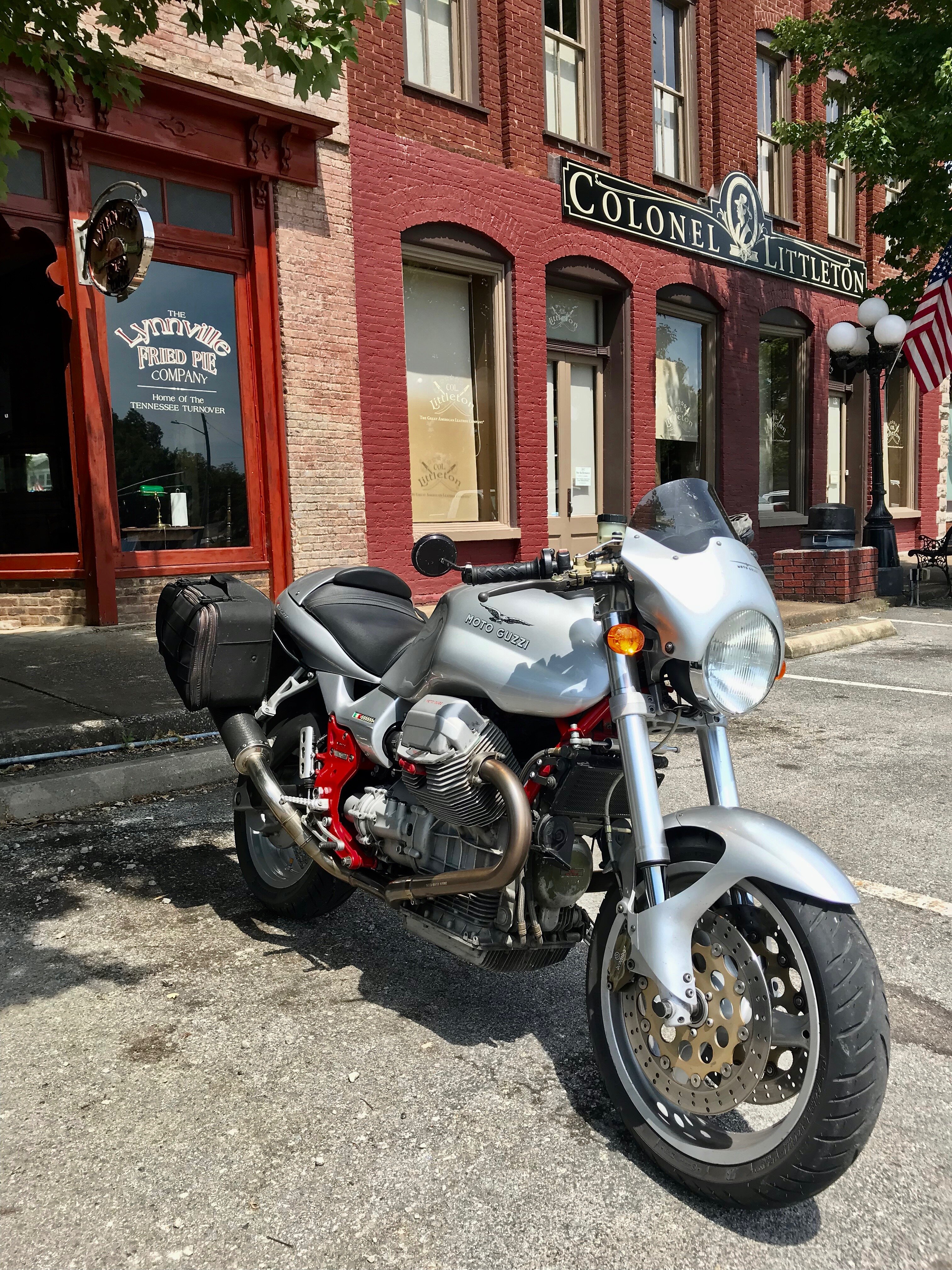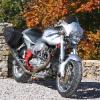-
Posts
19,845 -
Joined
-
Last visited
-
Days Won
1,123
Content Type
Profiles
Forums
Events
Gallery
Community Map
Everything posted by docc
-
My brother called me from Monticello, Georgia, on Sunday. Was on his Breva 1100. Said he thought he'd been by a rock about a mile out of town. When he got to the courthouse square, he learned what it probably was a 13-Year Cicada Rascals would take out the teeth of a novelty-helmet wearer ... well, assuming they still had some. OBTW, sure hope the weather stays as presently predicted: SSRVII Weather Doesn't reach Sat or Sun, but Fri is looking great. More importantly, it would seem that we are in for a longish unstable and wet pattern for many days before that weekend, so odds are good you want get as soaked as in past Raids. Yeah, I know. Figure the odds. And, Josh, Kathi wants you to bring baby pix. She hasn't told docc yet, but she wants to put on a multi-media presentation of our grandbabies in the lodge game room instead of the usual beer and partying. With 8 on the ground and #9 inbound and overdue. Could be a long session. Bill Really, no . . . a multi-baby power point? Is there going to be a quiz after? It should go well with the clack of pool balls! Definitely Saturday breakfast at the "Lodges at Tellico." Probably around 0800. Of course there will always be a debate whether that means Eastern time or Central. (Expect the EDT guys to prevail. Bill has what my folks always called "ants in yer pants.")
-
Looks like we'll be bringing a half dozen riders out of Middle Tennessee Friday am from MarcyJo's Mealhouse four miles east of I65/ exit 46 on the corner of TN Hwy 99 and US 431. We'll meet for breakfast about 8:30 CDT and take a selection of backroads east to Tellico Plains. Likely to arrive between 2:30 and 3:30 EDT. Saturday, expect an eastern loop over the Cherohala to the Dragon's Nose to take in the scene and on through Fontana for lunch in Franklin before a return along Wayah Rd and back over the Cherohala.
-
So, I realize one hose is simply a drain in the event you overfill the tank during fueling directing the overflow onto the tarmac (certainly un-good to drop that onto the top of your motor). I believe that's the big hole at eight o'clock on the left side under your gas cap. The other side allows air flow back into the tank while keeping the vapors from the atmosphere through the carbon cannisters and preventing "tip-over" spill with the nefarious little valve. I, uh, "inspected" my 2000 Sport's vapor recovery system. The canisters and plumbing weighed five pounds and there is twenty feet of half inch fuel line. No, really: twenty feet. I am sorry to report that my Sport has been on its side two or three times yet, even without the "tip-over valve," no fuel spilled. Both hoses will "Y" nicely together and route out the bottom. They are a (difficult female dog) to re-attach when replacing the tank, so I can see hourly employees giving it up.
-
A "Griso Cup" sound like an attachment for my gas grill for those really drippy Bratwurst . . . And everyone knows that *things* are faster with a bikini.
-
Huh, something similar happened to me with my 2000 sport in October 2008 ordering 1117530 from MI in Seattle, but receiving 1117590 instead. They were able to locate and ship a more correct cable 1117560
-
Ok, I've been bracing myself for the potential ribbing that might come my way for wiping gear oil off my rear wheel a second year in a row. After changing the outer (easy) big seal in the rear drive, the drip reduced to more of a splatter. The shop I found to change the inner seal had the main man out for six weeks with medical issues. Tuesday, he told me he couldn't guarantee getting the thing back together in the next couple weeks. In the meantime (is this sounding like a long, drawn out alibi?), I ordered my drive shaft from my local Moto Guzzi dealer in Seattle, Washington ( like 3000 miles from here) who ordered the piece from The Netherlands (like 10,000 miles from there). They said to expect a month, but after six weeks, there's no word on a delivery time. So, I packed an extra rag instead. The short answer is . . . no.
-
Sorting the rest of the relay bases is a good idea. As is grounding the regulator. Look also at the 30 amp regulator fuse. The contacts on this mini-fuse are rather undersized for the load and many of these fuses have melted or the contacts have burned off (without "blowing" the fuse!). Cleaning the contacts in the ignition switch is not difficult and will be worthwhile. Check your battery voltage and charging voltages with a digital meter. A weak battery is trouble for these systems. Look for battery voltage 12.7-12.84 and charging over 14 volts. Best of luck and keep us posted!
-
Bad news on that: Starboard is the right side of the ship. The Italian "S" is for "sinestra" (left) aka Simon Bar Sinister "S" is not for "starboard."
-
Pirelli makes no mention of dual compound; only a high silica content. I do like the Angels in the cold and wet. Really, they impress me as Diablo Strada with a gimicky tread pattern (the angels) that only lasts a few hundred miles. Kind of reminds me of a girl I once dated. She was a real angel, but only for the first couple rides!
-
My Angels and Diablo Stradas have been roughly equivalent, both in handling and mileage. I wonder if speeds, here in the USA, are somewhat higher than the continent and the UK. That's a hard measure to pin down. And even with that, the roads here in the southeast US are coarse and temperatures are often high - something I've long called the 90-90 wear pattern: 90 degrees Fahrenheit/ 90 mph: 3500 mile tire life!
-
I've a fellow rider coming along from Middle Tennessee who's booked a room and would like to split costs. If anyone is interested, pm me and I'll get you in touch with him.
-
"Dis side" - ha aha haha ! That's some precious eye'talian'merican stuff!
-
Hi, Ajonen, Apologies, but I thought we could address your timing question in this thread without a separate one. There is a rubber plug on the right side of the bell housing used to see the top-dead-center marks for valve adjustment ("D" for right and "S" for left). I don't think the flywheel has any actual timing marks. You may be able to make a mark, visible with a timing light, that would tell you if the timing is jumping around indicating a bad cam chain tensioner. Otherwise, there are some simple things to try first: -set your valves to "world spec" (0.006" intake/ 0.008" exhaust) *apologies for quoting "world spec" in inches, but I see you are in SoCal/USA* -Increase your idle to 1200-1500 rpm. Some of the tachs read 300-500 rpm low and no well cammed Guzzi likes a low idle. -Balance your throttle linkage very carefully. The fluid devices (like Mercury sticks) are more effective than the electronic devices (like "TwinMax") -be certain your air filter is clean and up to service and there are no air or exhaust leaks. Certainly some of these motors have suffered from needing valve and guide service, but let's try the simple stuff first!
-
Hmm, that appears to be the airbox drain. The bright red wire is the spark plug wire and the two should not be allowed out on a date by themselves! The center hose leaking before indicates the tank was not venting normally. I wonder: what did the shop change? Did they actually change the tank? Or did they reroute or plug off the vent lines? Normally, that airbox drain only captures incoming moisture. In order for it to be dropping fuel, raw fuel must be kicking back into the airbox.
-
This is the first I've heard of one going down. Is it mechanical or a pressure switch?
-
Cleaning the ignition switch per KiwiRoy's advice has been a real help to my "hi-mile" Sport. But, what is a good point to "anchor" the harness, and can I get to it without any dis-assembly?
-
Gene, I promise I will not tell that you polished your pipes with kitchen sink cleaner. The promise is good til the third beer. . .
-
Now we're riding the ragged edge, taunting the storm Gods, and smuggling home brew! I love this ride!
-
That's a pretty nice looking clock! I'm on my third Veglia (earlier than yours) after 76,000 miles. I use my Garmin ZUMO as a back-up. Is that unit cable driven or electronic?
-
I don't think it's the bolts themselves or even the U-joints. After several remove/refit operations by several, um, technicians, I don't think the collars retain the fasteners well any more. The factory change interval on the shaft is worrisome, and I can only be sure I've got grease in the front U-joint a couple times, even after trying, over the last ten or eleven years. I've got to remove the rear drive for seals and I just can't trust the shaft at the typical speeds I might approach (90-100 mph). Sure, a new shaft is six or eight hundred dollars. New bikes are ten or twelve thousand and an MRI or CAT scan ranges 600- 5,000 USD. I'm looking forward to the confidence of having a fresh new drive shaft.
-
After 76,000 miles, I'm replacing my drive shaft. I know I've gotten grease in it twice for sure. Trouble is, it's been removed and replaced four or five times for other reasons and I don't trust the pinch bolts and collars anymore. Apparently, Teo Lamers in Holland has replacements for much less than $800 USD.
-
Steve, Has your original gone missing? (I'm afraid to take my tank bag off that the cover might blow away!)
-
Good replies on checking the bearings versus the brakes. It is really common for some of the pistons to begin sticking. Bleeding the brakes while freeing the pistons, all, will improve the braking and reduce any drag from sticking pistons along with the uneven movement of the pads against the rotors.
-
Good advice so far. With the Sport-i so similar to the V11 variants, I think we're in the right forum for this discussion. We might could all learn a thing or two from it. You say when the bike is off, the throttle snaps back closed? No chance the cable or linkage is rubbing (have a look)?


